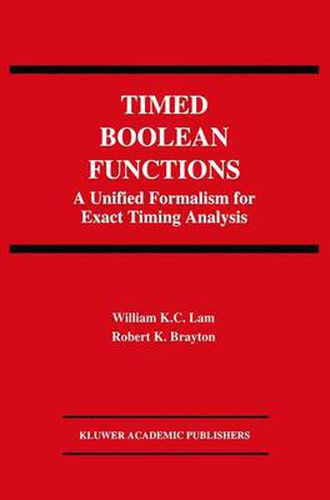Readings Newsletter
Become a Readings Member to make your shopping experience even easier.
Sign in or sign up for free!
You’re not far away from qualifying for FREE standard shipping within Australia
You’ve qualified for FREE standard shipping within Australia
The cart is loading…






This title is printed to order. This book may have been self-published. If so, we cannot guarantee the quality of the content. In the main most books will have gone through the editing process however some may not. We therefore suggest that you be aware of this before ordering this book. If in doubt check either the author or publisher’s details as we are unable to accept any returns unless they are faulty. Please contact us if you have any questions.
Timing research in high performance VLSI systems has advanced at a steady pace over the last few years. Tools, however, especially theoretical mechanisms, lag behind. Much of the present timing research relies heavily on timing diagrams which, although intuitive, are inadequate for analysis of large designs with many parameters. Further, timing diagrams offer only approximations, not exact solutions to many timing problems and provide little insight in the cases where temporal properties of a design interact intricately with the design’s logical functionalities. This text presents a methodology for timing research which facilitates analysis and design of circuits and systems in a unified temporal and logical domain. The book aims to present the central idea of representing logical and timing information in a common structure, (TBFs), and to present a canonical form suitable for efficient manipulation. This methodology is then applied to practical applications to provide intuition and insight into the subject so that these general methods can be adapted to specific engineering problems and also to further the research necessary to enhance the understanding of the field. The text is written for professionals involved in timing research and digital designers who want to enhance their understanding of the timing aspects of high-speed circuits. The prerequisites are a common background in logic design, computer algorithms, combinatorial optimization and a certain degree of mathematical sophistication.
$9.00 standard shipping within Australia
FREE standard shipping within Australia for orders over $100.00
Express & International shipping calculated at checkout
This title is printed to order. This book may have been self-published. If so, we cannot guarantee the quality of the content. In the main most books will have gone through the editing process however some may not. We therefore suggest that you be aware of this before ordering this book. If in doubt check either the author or publisher’s details as we are unable to accept any returns unless they are faulty. Please contact us if you have any questions.
Timing research in high performance VLSI systems has advanced at a steady pace over the last few years. Tools, however, especially theoretical mechanisms, lag behind. Much of the present timing research relies heavily on timing diagrams which, although intuitive, are inadequate for analysis of large designs with many parameters. Further, timing diagrams offer only approximations, not exact solutions to many timing problems and provide little insight in the cases where temporal properties of a design interact intricately with the design’s logical functionalities. This text presents a methodology for timing research which facilitates analysis and design of circuits and systems in a unified temporal and logical domain. The book aims to present the central idea of representing logical and timing information in a common structure, (TBFs), and to present a canonical form suitable for efficient manipulation. This methodology is then applied to practical applications to provide intuition and insight into the subject so that these general methods can be adapted to specific engineering problems and also to further the research necessary to enhance the understanding of the field. The text is written for professionals involved in timing research and digital designers who want to enhance their understanding of the timing aspects of high-speed circuits. The prerequisites are a common background in logic design, computer algorithms, combinatorial optimization and a certain degree of mathematical sophistication.